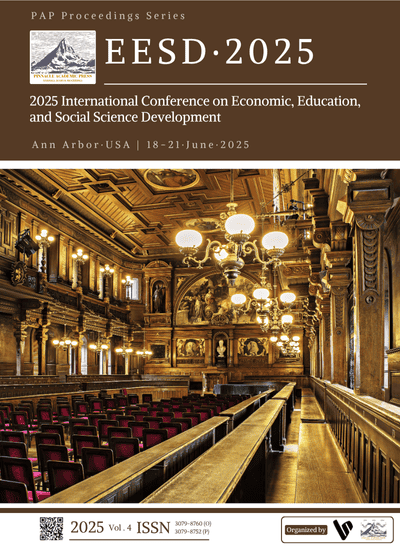An Exploration of the Connection between Sima Xiangru's FU and Shu Cultural Elements
DOI:
https://doi.org/10.71222/wjsdrr11Keywords:
Sima Xiangru's fu, Shu cultural elements, connectionAbstract
The abundant material and spiritual wealth of Shu, spanning millennia, vividly manifests in Sima Xiangru's fu works, transforming into a romantic breeze that still captivates readers across centuries. By disseminating his literary pieces throughout the Han Empire and to later generations, Sima Xiangru created a series of renowned fu compositions, whose grand and elaborate diction exerted an undeniable influence on the establishment of Shu's cultural paradigm. Through elegant prose that satirizes the pursuit of power and conveys admonitions with literary ingenuity, Han fu from Shu further distinguishes itself with its profound underlying themes, shining as a brilliant star in the history of Chinese civilization and serving as a guiding beacon for repeated scholarly interpretation. Therefore, this study analyzes the connection between Sima Xiangru's fu and Shu cultural elements based on his six extant fu works.
References
1. T. Qin and L. Jia, "THE INTERNATIONAL COMMUNICATION OF BASHU CULTURE UNDER THE BACKGROUND OF “BELTAND ROAD”," 2025, doi: 10.61784/hcj3004.
2. Y. Zheng and S. Saelee, "Shu Embroidery in Sichuan, China: The Social Life of Things from a Cultural Perspective and Their Contemporary Evolution," Cultura: Int. J. Philos. Cult. Axiology, vol. 22, no. 1, 2025.
3. W. J. Cynarski, "The Invention of Martial Arts: Popular Culture Between Asia and America: By Paul Bowman, New York, NY, Oxford University Press, 2021, 262 pp., £ 28.99 (paperback), ISBN 978-0-19-754034-3, £ 90.00 (hardback), ISBN 978-0-19-754033-6," 2023, pp. 235-236, doi: 10.1080/27690148.2023.2239651.
4. X. Wang et al., "How can archaeological scientist integrate the typological and stylistic characteristics with scientific results: a case study on bronze spearheads unearthed from the Shuangyuan Village, Chengdu City, Southwest China," Curr. Anal. Chem., vol. 17, no. 7, pp. 1044-1053, 2021, doi: 10.2174/1573411017666210111095416.
5. X. Fu, "Fu and the Evolution of Chinese Ancient Narrative," in Chinese Narratologies, Singapore: Springer Singapore, 2020, pp. 157-174, doi: 10.1007/978-981-15-7507-5_8.
6. M. D. Gu, "Fu-bi-xing: A metatheory of poetry-making," Chinese Literature: Essays, Articles, Reviews (CLEAR), vol. 19, pp. 1-22, 1997, doi: 10.2307/495087.
7. N. Wang, "'Fu, Bi, Xing': The stratification of meaning in Chinese theories of interpretation," J. Orient. Soc. Aust., vol. 24, pp. 111-123, 1992.
8. D. Cai, "Literature in the Western and Eastern Han Dynasties," in Concise Reader of Chinese Literature History, Singapore: Springer Nature Singapore, 2023, pp. 85-113, doi: 10.1007/978-981-99-5814-6_9.
9. Y. Cheng and G. Patterson, "Empire in Text: Sima Xiangru’s “Sir Vacuous/Imperial Park Rhapsody” (“Zixu/Shanglin fu”)," in How to Read Chinese Poetry in Context: Poetic Culture from Antiquity Through the Tang, Columbia University Press, 2018, pp. 51-64, doi: 10.7312/cai-18536-009.
10. N. M. Williams, "Inventing the Fu: Simulated Spontaneity in Sima Xiangru's 'Great Man'," in Reading Fu Poetry: From the Han to Song Dynasties, Arc Humanities Press, 2022, pp. 1-38. ISBN: 9781641894913.
11. P. Krasilnikov et al., "Soil in the shamanism mythology and rituals in northern Eurasia," in Cultural Understanding of Soils: The importance of cultural diversity and of the inner world, Cham: Springer International Publishing, 2023, pp. 117-133, doi: 10.1007/978-3-031-13169-1_5.
12. P. Zhuang and J. Zhang, "On Variations of the Classical Chinese Literary Genre terminchinesescript (Fu) in Literary History," Cultura, vol. 19, no. 2, pp. 131-145, 2022, doi: 10.3726/CUL022022.0009.
13. Y. Zhou and F. Yu, "Integration of traditional Chinese music: an evaluation of the interactive influence between traditional music and aesthetic thought," Trans/Form/Ação, vol. 47, no. 5, 2024, Art. no. e02400180, doi: 10.1590/0101-3173.2024.v47.n5.e02400180.
14. M. Cheng, "Analysis of the Transformation of Elegant and Popular Music from Zhou to Han Dynasty Based on the Nature of Musical Entertainment: Introduction," Cultura: Int. J. Philos. Cult. Axiology, vol. 21, no. 2, 2024.
15. Z. Huang, "To explore the artistic, cultural and education characteristics and inheritance of dance in of music and dance of silk road in the Han and Tang dynasties," Arts Educa, vol. 38, 2024.
Downloads
Published
Issue
Section
License
Copyright (c) 2025 Xincheng Ying (Author)

This work is licensed under a Creative Commons Attribution 4.0 International License.



